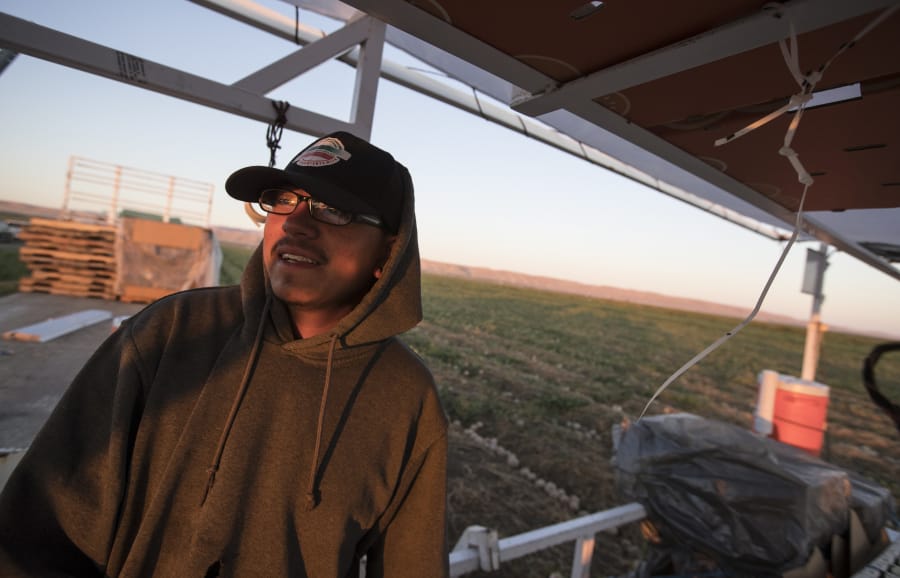FIREBAUGH, Calif. — Nicholas Andrew Flores swatted at the flies orbiting his sweat-drenched face as he picked alongside a crew of immigrants through a cantaloupe field in California’s Central Valley.
He didn’t speak Spanish, but he understood the essential words the foreman barked out: “Puro amarillo.” And “rapido, rapido!” Quickly, Flores picked only yellow melons and flung them onto a moving platform.
It was hard and repetitive work, and there were days under the searing sun that Flores regretted not going to a four-year college. But he liked that to get the job he just had to “show up.” And at $12 an hour, it paid better than slinging fast food.
For Joe Del Bosque of Del Bosque Farms in the San Joaquin Valley, American-born pickers like Flores, though rare, are always welcome.
For generations, rural Mexico has been the primary source of hired farm labor in the U.S. According to a federal survey, nine out of 10 agricultural workers in places like California are foreign-born, and more than half are in the U.S. illegally.
But farm labor from Mexico has been declining in California. And under the Trump administration, many in the agricultural industry worry that deportations — and the fear of them — could further cut the supply of workers.
But try as they have to entice workers with better salaries and benefits, companies have found it impossible to attract enough U.S.-born workers to make up for a shortage from south of the border.
Del Bosque said he’ll hire anyone who shows up ready to work. But that rarely means someone born in the U.S.
“Americans will say, ‘You can’t pay me enough to do this kind of work,’ ” Del Bosque said. “They won’t do it. They’ll look for something easier.”
For some immigrants working the fields, people like Flores are a puzzle — their sweating next to them represents a kind of squandering of an American birthright.
“It’s hard to be here under the sun. It’s a waste of time and their talents in the fields,” said Norma Felix, a Mexican picker for almost three decades. “They don’t take advantage of their privilege and benefit of being born here. They could easily work in an office.”
Most don’t last long, she said.
“There is always one or two who show up every season,” Felix said. “They show up for three or four days and turn around and leave.”
Agriculture’s reliance on immigrant labor, especially in the American West, goes back to the late 1800s, after the completion of the First Transcontinental Railroad, said J. Edward Taylor, a rural economist at the University of California, Davis.
“The domestic farm workforce was simply not big enough to support the growth of labor-intensive fruit and vegetable crops,” he said.
With the notable exception of the Dust Bowl years in the 1930s — when American migrant workers from Oklahoma, Arkansas, and Texas moved west after a severe drought devastated their livelihoods — there was never a time when California crops were picked primarily by U.S.-born farmworkers, Taylor said. Those workers eventually moved on to nonfarm jobs.
Now, Mexico is undergoing some of the same changes the U.S. did around the middle of the 20th century, Taylor said, with “employment shifting from farms to industry and services.”
According to Taylor’s research, the number of farmworkers coming out of rural Mexico is decreasing by an estimated 150,000 a year. That means U.S. and Mexican farmers will have to increasingly compete for a dwindling pool of labor.
Some advocates of restricting immigration see more farm mechanization and importing fruits and vegetables as ways to reduce the reliance on labor from illegal immigration.
“If we tighten immigration rules, there are going to be fewer farm jobs, but they will be better-paid. They will be more stable and consistent with more regular jobs,” said Mark Krikorian, executive director for the Center for Immigration Studies in Washington. “That should be the goal. Huge increases in individual productivity so where you now need 200 farmworkers working seasonally, a farmer would be able to employ 10 people year-round, full-time.”
Taylor said there’s reason to believe that technology would take over before pay increased enough to attract U.S.-born employees to the fields in large numbers.
“We would develop new picking machines, including robotic harvesters, and use them out in the fields instead of paying wages that could possibly be high enough to induce some U.S.-born farmworkers out into the fields,” he said.
In California, farm wages increased 13 percent from 2010 to 2015, according to a Los Angeles Times analysis of data from the Bureau of Labor Statistics. Some farmers have resorted to giving field laborers benefits such as 401(k) plans, health insurance and even subsidized housing.
But they’ve still struggled to recruit enough workers.




